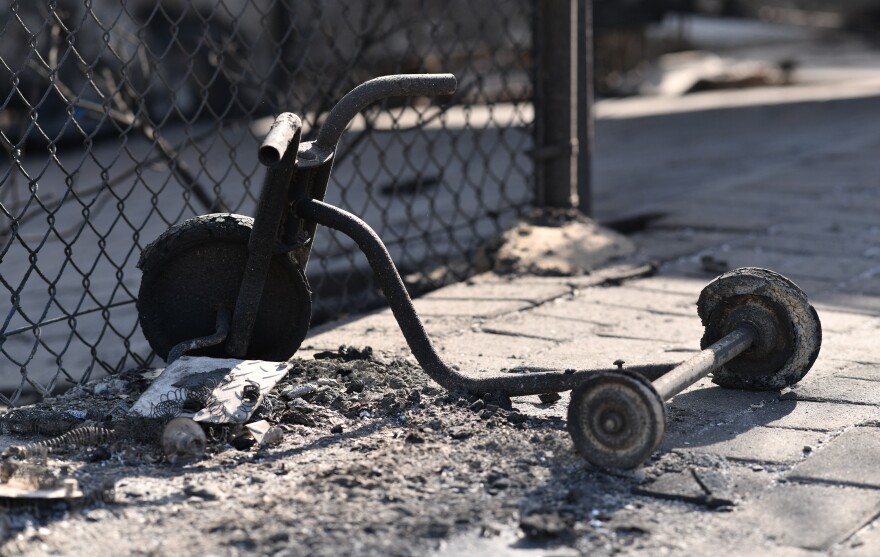Truth matters. Community matters. Your support makes both possible. LAist is one of the few places where news remains independent and free from political and corporate influence. Stand up for truth and for LAist. Make your year-end tax-deductible gift now.
Dear LAist: How long could ash be a problem in LA?

You’ve probably heard about this a lot lately: Ash can be found around Los Angeles County from the recent wildfires and residents should be careful cleaning it up.
We’ve offered guides and tips to dealing with ash in your belongings because the dusty residue is essentially the toxic byproduct of all that’s burned — electronics, paints, and furniture — that can contain harmful substances.
But readers have reached out with two big questions: How at risk are people who live farther away from the burn scars? And how long could the ash problem persist?
Is there a range?
Ed Avol, professor emeritus at USC’s Keck School of Medicine and former chief of its environmental health division, said the recent rain would likely reduce ash’s ability to travel in the air.
“It will tend to damp down and discourage the resuspension, the kicking up of this dust back into the air,” Avol said.
While the rain has tempered a lot of ash, it could still linger on the ground and nooks and crannies around your home that will eventually dry up again. Then it would be light enough to become airborne once again. And during high winds, that renews the spread concern.
You may have seen posts on social media saying if you’re within “X” amount of miles from Los Angeles, you should be concerned. But it’s not that simple — smoke and ash can affect air quality hundreds of miles away, as we saw during the Canada wildfires in 2023.
Avol said we can’t draw lines in the street and say, “If you’re on this side, you’re OK. And if you’re on the other side, you’re in trouble.”
“It’s a gradual curve that diminishes with distance risk being relative,” Avol said. “And so in some ways, the farther away you are, the lesser the risk is from inhaling or having some of this debris falling.”
Nahal Mogharabi, assistant deputy of communications at the South Coast Air Quality Management District, said distance is tough to pin down because it depends on multiple factors, like wind direction and speed.
“Ash from the initial smoke plumes has likely already fallen and settled out,” Mogharabi said. “However, on high wind events, there is potential for ash from the burn areas to be resuspended and move across the entire region.”
For example, the South Coast AQMD issued multiple advisories for windblown ash and dust during the Santa Ana wind events. One advisory on Jan. 13 showed potentially affected areas stretching from Thousand Oaks to past Indio in the Coachella Valley. On Jan. 22, another advisory used a reduced boundary covering northwest L.A. County and parts of the Inland Empire. (Both advisories have expired.)
A general rule of thumb is if you see ash on the ground, which can be as small as a grain of sand, then you should take precautions, because you’re likely in the dispersal path.

How long do I have to watch for ash?
Just like with distance, Mogharabi said there is no definitive answer to how long the transportation of ash could happen.
“In fires that have burned wildland areas, we have seen ash transported on windy days until the vegetation regrows in the spring,” Mogharabi said. “However, these fires impacted a highly populated area, so urban ash could be very different.”
_
As crews clean up debris, ash will inevitably get dispersed back into the air. In the long term, ash removal could take years, but Avol said conditions won’t all be the same.
For example, urban areas will likely be cleaned up much faster and more thoroughly over the next several months to allow people to return home. But you may still come across ash in outlying forest or rural areas for much longer.
What does this mean for me?

Avol had a few tips for folks who are especially anxious about ash exposure because “there are ways to obtain the information to make informed choices.”
For example, you could limit outdoor activities and wear an N-95 mask if you’re closer to the fires or see ash on the ground. People have different levels of sensitivity to ash, so consulting your doctor could be another tool. Young children, people over 65, and those who are immunocompromised are more at risk for health issues.
And while the Air Quality Index isn’t able to properly detect ash particles, the AirNow fire and smoke map can help you understand conditions around you generally. Weather apps can tell you what direction and speed the wind is blowing, which can help people living near the burn scars understand if wind patterns could blow things their way.
“I think that can be useful and help maybe tamp down some of the paranoia and anxiety about what might be happening,” Avol said, “and at least make you feel like you’re more in control and have some information on which to base decisions.”











